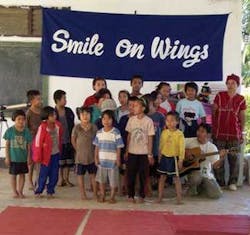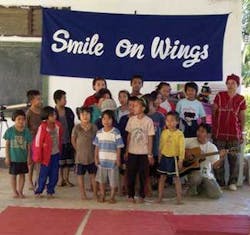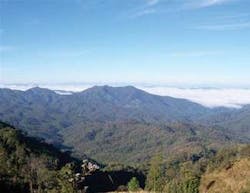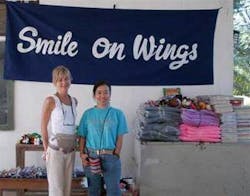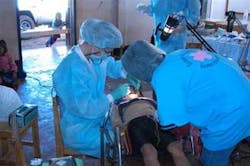“I Promised Them a Blonde”
A dental mission to remote villages of Thailand
When the tsunami struck on Dec. 26, 2004, I was finally ready to join a dental mission to Thailand. Thai native and public health co-worker Usa Bunnag, DDS, had been after me for years to join her humanitarian organization called “Smile on Wings.” The organization’s mission is to provide dental care to children in remote mountain villages outside of Mae Sariang, Thailand.
Volunteerism is in my blood, but my husband, teenage son, and four pets caused me to hesitate about making a 24-hour trip to the other side of the world. I also could not envision traveling 24 hours only to continue the dental work I have done for the last 30 years! Fortunately, my husband, Wayne, who is a patient of Dr. Bunnag’s, encouraged me to go. For her part, Usa promised me touristy activities in Thailand.
Then the tsunami hit ...
After that, it took another year for me to coordinate my schedule with “Smile on Wings.” A dental mission team usually included Dr. Bunnag, hygienists, assistants, other medical providers, and the staff of the Mae Sariang Hospital Dental Clinic. A change in Dr. Bunnag’s schedule shrank our team to her, her husband, her two sons, their friend, and me. Dr. Bunnag and her family went before me so that they could commemorate the tsunami anniversary in Phuket.
Why did Dr. Bunnag promise the Thai people a blonde? Her previous missions had included many Americans, but few green-eyed blondes. She knew that not only would my hygiene skills be in demand, but a huge cultural statement would be made. To tell the truth, my son, Ben, teases me about bleaching my hair.
Dr. Bunnag met me at the Bangkok Airport the evening of Jan. 1, 2006. The next morning we flew north to Chaingmai, then drove three hours through “the land of 1,000 curves” to “the land of the mists,” Mae Sariang.
A patient of Dr. Bunnag’s had teased me earlier. “Oh, I hear you’re sleeping in tents!” he said. I figured Dr. Bunnag had glossed over that little detail, but I knew I would be a trooper for whatever time and sleeping conditions were required. We didn’t sleep in tents, but admittedly, the mattress at the River House Hotel in Mae Sariang was hard as a rock. However, the river setting was lovely and the staff was truly helpful.
Our first full day in Mae Sariang began with Dr. Bunnag and me purchasing schoolbooks and other educational materials for a school in Sobmuay, located on the Salaween River on the Burmese border. Sobmuay is another ride on mountain roads and an hour-plus boat ride through a Grand Canyon-like setting.
At the harbor, we met an Australian woman with blonde hair and blue eyes who caught the attention of three people who stared and pointed at her eyes. I finally realized it was the blue of her eyes that had caught their attention when they pointed to a blue shirt. I pointed to a man’s green shirt, took off my sunglasses, and showed them my eyes. They laughed, and kept looking at the Australian and me until we left on the boats.
There are very few homes along the Salaween River. The only ones are located in Sobmuay at the fork of two rivers across from Burma. Due to political issues, we were required to be off the river and back at the harbor before dark. But, first, we had an adventure in Sobmuay that included presenting the school with supplies, educational toys, and dental products.
In return, the villagers and children performed a “Bamboo Dance,” sang, and invited us to tour their tiny village. Sobmuay is much like the three villages where we were to provide dental treatment: four to six teachers for each 110 to 160 students of all ages and grades. However, Sobmuay has not only a school, but also a medical clinic.
The population of the villages is tribal, such as the Karen tribe, with different Thai dialects. To help with translation during dental treatment, teachers and the Mae Sariang Hospital Dental Team stepped in.
Our second morning, Dr. Bunnag and I donned our “Smile on Wings” t-shirts and met with the Mae Sariang hospital’s dental team. We then traveled to another remote village in a four-wheel drive over rough roads rutted out by the rainy season. The views were outstanding! Up and down the mountains, above the mists. The orchards and fields of rice and cabbage growing on the mountainsides reminded me of the steep Black Diamond slopes of ski areas. How do the farmers do it?
We followed much of the same routine at each of the three village schools. We arrived, set up the hospital mobile units in a classroom or workroom, and began treatment. The children who had been pre-screened by the Mae Sariang team lined up. I taught dental care to some teachers and students, which they in turn passed on to other students. Dr. Bunnag and Dr. Yui of the Mae Sariang Hospital Dental Team filled and extracted teeth. I placed sealants and performed prophies and fluoride treatments. We placed most fillings without anesthesia! Of the hundreds of students we treated, only one cried, and that was at the prospect of having a fluoride treatment! The students were truly brave.
What I also noticed about the children was their good manners. They always said “suwasdee-ka” or “kop-koon-ka” (“hello” and “thank you”). Those children whose parents could afford it bought uniforms. Some children were boarders, others walked miles to get to school each day.
What about infection control in this environment? Well, the CDC and OSHA do not approve of bare feet, but Buddhist tradition requires that out of respect, shoes be removed before entering a building or home. Some of us wore socks. What about dogs? Both dogs and cats came and went from our “clinic” area at will. Children peered into open windows to watch their classmates being treated.
The view was outstanding. While waiting for a patient to be seated or a chair to be wiped, I stared at the mountains, wild poinsettias, and bougainvillea. It was like no hygiene room I have ever worked in, or will ever work in again!
The dental team was able to provide care to about 30 patients each day. I left wishing I could have done more. Considering that Thailand’s public health system has one dentist per 15,000 people, I know we accomplished something. One group of students had not seen a dentist in nearly 10 years! They had many “bombed out” teeth, cavities, and need for extractions. I felt that home care education for the teachers and parents would have great results. Instead, the teachers at our last stop were trying to teach the families that they should not sacrifice black dogs to the spirits. Teaching the ill effects of sugar? The least of their problems!
When we completed our treatments for the day, we held a thank-you ceremony with gifts and photos, and gave every student a toothbrush and sticker. Many of our supplies came with us from the U.S., and the stickers became extremely popular facial decoration. After we said our final goodbyes, we made the trip back down the mountains.
I am extremely grateful to have had the opportunity to be part of “Smile on Wings: Giving help, giving hope.” I received far more than I gave in terms of the people, their culture, and the experience.
But this is always true of volunteer work, isn’t it? I am truly honored that Dr. Bunnag felt I was up to the demands of such a mission, as this is not an experience for everyone. However, if you have the desire to help people in need, every community has programs that need volunteers. I just wanted to go where few blondes have ever gone before!
After our clinical work, I traveled for an additional eight days to Chiangmai, Bangkok, and Phuket. The people were friendly, the food delicious and inexpensive, and the shopping, well, I purchased 20 pashmina shawls to share with my family and friends!
I traveled to Phuket by myself - quite a bit “pooped” after 25 hours of air travel a week earlier from Washington, D.C., a difficult case of jet lag, four days of work which included four hours per day of travel time to clinic sites on very bumpy roads, and a nonstop, but well-prepared sight seeing extravaganza.
Upon arriving in Phuket, which is rather a large area, I decided that I did not want to remember my trip to Thailand in that way - that being the tsunami devastation.
The Thai area affected by the tsunami was rather small. The tourists had returned and building projects flourished. I chose to relax for the 2½ days that I had in Phuket.
However, upon walking the beach at 7:30 in the morning with virtually few other people in sight, I was overwhelmed by the beauty, peacefulness of the area, and the ice-rink flatness of the water. It struck me how truly frightening it must have been to see a wave of such size. It was one of those moments when I counted my blessings and sent out my prayers.
